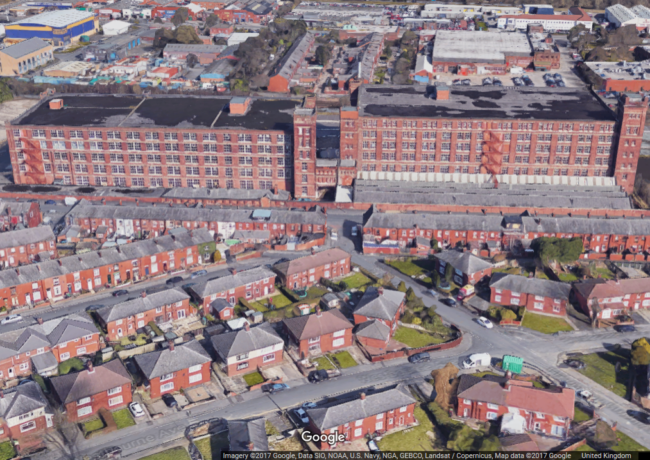Outrage and elation as Bolton listed mill demolition looks likely
The demolition of a 520,000 sq ft listed mill complex in Bolton looks set to go ahead, in line with planning consent granted last year, after the Secretary of State confirmed he would not be intervening and Historic England withdrew its objections.
Arndale Properties’ plans to pull down the grade two-listed Beehive Mill on Crescent Road, to make way for 121 new houses on the nine-acre site, were approved against officer recommendations by Bolton Council in October 2016.
While the council’s planners highlighted the historic significance of the buildings and their listed status, councillors decided that the need for housing, and the “eyesore” nature of the vacant property, outweighed the heritage value.
The decision was referred to the Secretary of State, then Greg Clarke, now Sajid Javid, as part of the council’s due process, due to the listed status. An inquiry was set to take place next month, and has been cancelled.
The redevelopment of the vast mill represents an ideological sticking point within the regeneration industry, with heritage conservation priorities on one side, versus the argument for meeting local housing demand and profitable development on the other. While the preservationist Victorian Society has said it is “shocked and disappointed to hear the news”, local councillors have celebrated that the delivery of new homes can go ahead.
According to Arndale’s planning application, submitted last year, the “owner has considered all reasonable uses of the building”, but the estate wasn’t viable for commercial use, or as a residential conversion.
The application estimated a conversion cost of £52m, which the developer said would leave a £30m loss. In the best case scenario, Arndale estimated a £13m deficit, and also said that “there is very little demand for flats in the area”.
Even the local response to the application was mixed, with representations calling the mill “an eyesore” and a “monstrosity that could be subject to arson”, while objectors countered that “buildings are listed for a reason”, with some even against the idea of residential development altogether as “this is not a prosperous area and the properties are likely to remain empty and attract vandals”.
According to Historic England, the organisation has “done all that we reasonably can to challenge the decision” but has withdrawn its objections, on the proviso that “the buildings would only be demolished if the works to construct the replacement housing were ready to start on site and a contract for their construction signed.”
The success of the demolition application also indicates the difficulty in bringing the North’s industrial heritage assets back into use, as Historic England highlights: “Having commissioned a survey into the site’s viability we recognise that the gap in funding to make the conversion financially viable is large and is unlikely to reduce. This exceptional case illustrates the challenges that we face in managing our industrial heritage in places where demand and values are low.”
Within Arndale’s own planning report, it said that Historic England had confirmed that grant funding was limited “and a project of this scale would not be attractive”.
The owner also said that it couldn’t turn to the £300m Greater Manchester Housing Fund for assistance, as even a loan was not “fundamentally viable”.
A council spokesman said: “We are pleased that the Secretary of State has withdrawn his call-in decision. This took place following positive discussions with Historic England and the applicant.
“Historic England withdrew their objection to the proposals following an agreement with the council and the applicant that demolition would not take place until a signed contract to redevelop the site was in place to the satisfaction of the planning authority, subject to consultation with Historic England.
“This condition has been agreed by all three parties. The council will now be issuing outline planning approval for the application once the section 106 agreement has been completed.”





Reet Shame.
By F Dibnah
I am torn by this and can see both sides. How long should an unviable listed building remain standing and gradually falling into disrepair?
By Rachel
Understand the loss of the listed building but dreadful shame the end product is only about 33 dwellings per hectare – this site is 20 minutes walk from Bolton Station, closer still to various facilities on the fringes of the town centre, something approaching double the density ought to be realistic and a far more efficient use of the land. 33dph in locations like this is a big part of why GM is having to contemplate significant greenbelt release.
By InterestedParty
It all depends on your assessment of ‘ unviable’.
In a few years time it may be wholly ‘viable’ but it will be too late by then.
I suspect the owners haven’t exactly bust a gut in seeking interesting and alternative uses.
By Nick ' Goose' Bradshaw
It is reasons such as this why Bolton is now a total and utter depressing dump. So bad it makes the national press. Heritage is all that is has to offer, get rid of that and it will be a deserted backwater within 2 decades. The place will get everything it deserves if this is a sign of things to come. A moronic, myopic decision.
By Loganberry
This is a powerful illustration of just how little we value our industrial heritage. These are listed buildings! The council and the heritage bodies could seek grant funding to bridge the viability gap but chose not to. They chose not to because fundamentally they do not value ithem. As a country we chuck money at stately homes and more conventional structures but who cares about a pair of listed mills in a northern town eh?
These buildings are part of our landscape and identity. Part of Bolton’s story. Nothing of their ilk will be built again and once gone, they’re gone forever. It’s beyond comprehension anyone could celebrate their demise and the pathetic nature of the scheme they hope to replace them with just adds to the absurdity. Mills have been successfully repurposed as housing or workspace throughout the region; this decision demonstrates a failure of imagination and a total lack of ambition for the town.
By Angry
The mills could provide flats, live work units and affordable startup/office space – so wouldn’t be unviable given the density. The reuse would be highly sustainable. How come warehouse conversations are so popular elsewhere and command a premium price? It’s a lack of imagination from the site owners. This could have been a co-housing /starter home mixed us village. Historic England need to get a grip of their raison detre!
By MetroMark
Nobody forced the developer to buy the mill. Tough if it’s not financially viable, that’s your problem mate! Sell it on, take the kick, you bought it, why the hell should the rules be bent and a town lose a huge part of history so you can make a few more million? I have no doubt that plenty of people will take it off your hands and make it viable. Absolutely inexcusable.
By Loganberry
People in Bolton don’t need to live in flats, they should be living in houses. This building is useless in this location.
By Lil Mo
Mills are stunning,but they are generally in the grottiest parts of the towns they used to serve.Bolton is a horrible dirty town.What makes it more depressing is,that in the 80s it was streets ahead of the other Milltowns for shopping, leisure facilities etc.I used to look in awe at the department stores and fantastic covered market,compared to Oldham,my hometown,it was like visiting Manhattan.There was a real confidence about Bolton.What went wrong?
By Elephant
this is a dangerous precedent to set. It ecorages greedy property owners to actively manage the decline of their assets and then claim that it is unviable to do anything to them
By Heritage Harry
Having grown up in the area and seen these magnificent mill towers in the distance from early childhood I feel great sadness at their imminent loss. My grandparents and earlier ancestors worked in the cotton industry and short sighted council decisions are robbing us of our heritage. These are beautiful buildings, albeit in poor current condition. To destroy history and replace it with ‘little boxes’ is so wasteful when these would be fantastic apartments with close road and rail links, brilliant views and irreplaceable atmosphere. No cause for rejoicing here!
By Ann
People are saying that this is in a run down area. So what’s the plan to rejuvenate it? Destroy its biggest asset and replace with low quality housing? How on earth is that supposed to work? Look at a pictures of Castlefield in the 70’s and tell me that was a desirable place to live, ditto Ancoats in the 90’s. Criminal short-sightedness, how the people who make these decision are given that amount of power is beyond me. I wouldn’t let 90% of local councillors look after a cat, never mind look after towns and cities.
By Loganberry
I’m afraid most mills across GM and Lancashire now blight their adjacent communities and have done for years. If they are not economic or practical to convert (and clearly most aren’t) then re-using mill sites has to be welcomed surely?
By Depressed Latic
Another piece of history gone, Bolton Council an absolute joke really a grade 2 listed building being demolished its a joke
By Neil Prescott
I think this is a shame but agree the developer shouldn’t have bought it if they no doubt knew this all along.
@MetroMark “How come warehouse conversations are so popular elsewhere and command a premium price?” because they are not backing onto a railway line, with views over to a dual carriageway, in Bolton.
@Loganberry – Castlefields & Ancoats are walking distance to Manchester City Centre, that’s why they are viable to regenerate. In an area where a refurbished 3 bed terrace struggles to get £80k the sums don’t add up for trendy mill/ loft conversions.
By Places change
Not unusual in today’s socio economic climate- the lack of will to reconfigure these astoundingly well built mills where corbeling and creative use of terracotta masonry is sadly lacking – this particular mill could easily become apartments for singletons and families alike – many Northern towns and cities have proved this to be much more socially viable- This building described by sone objectors defines their lack of aesthetic appreciation – I also have concerns that the site development will have not one affordable home – and the pithy donation to the “community chest” as a sweetener to Bolton Education is derisory – shame Bolton has such poor vision – look what could have been at the Church Wharf site – No Canal No Water ? Filled in to accommodate St Peters Way!! Wigan Council kept the mill and the canal – do your homework better BOLTON Council
By Vasco De Gama
Bee Hive mills to be demolished ? Congratulations Bolton Council on doing what they do best tearing up the town’s historical heritage and tourist attraction it once had = The Commercial Hotel @ Victoria Square demolished for Mothercare now a Bank, Palais de Dance = R.I.P. , Horwich Loco Works, no thought of a Railway museum? The Bolton/Bury Canal terminal a missed opportunity for a leisure attraction which could be developed as a country walk , Bolton’s former Fire Station at Marsden Rd now replaced with a block of flats that from a distance resembles a stranded ship, the Manchester Rd college was an Iconic building – demolished and left vacant for years making the southside of Bradshawgate derelict, when will the Swan Lane mills once the World’s biggest cotton spinner be the next victim of Bolton Councils demolition squad, the list goes on for there are many more too numerous to mention, Bolton is truly a place to get away from to the benefit of other nearby towns & centres.
By John Ferris.